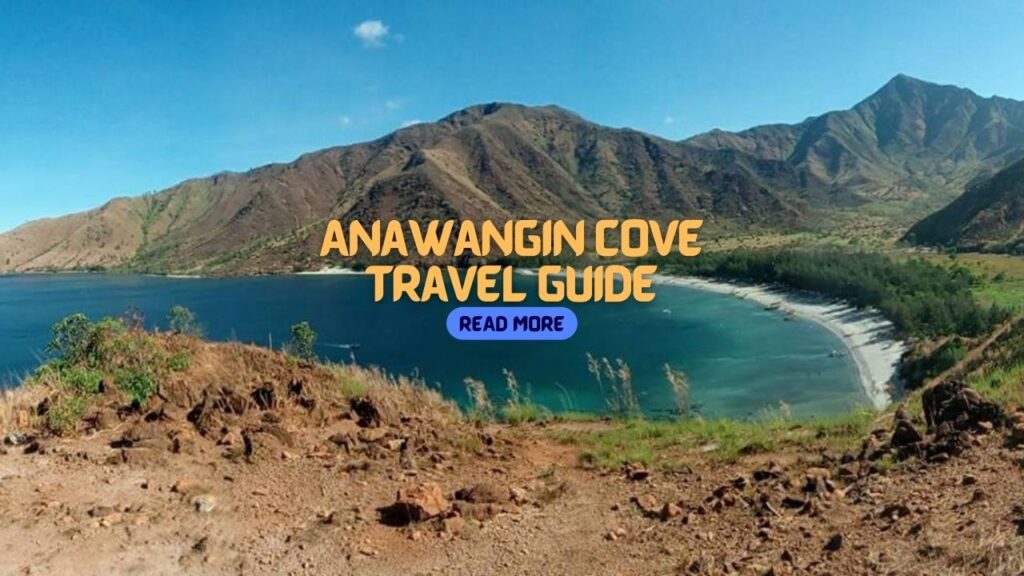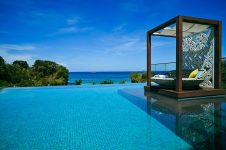ANAWANGIN COVE TRAVEL GUIDE: How to get There, Budget + Itinerary
13 min read
Your Ultimate Travel Guide to Anawangin Cove in Zambales
Anawangin Cove presents a unique blend of natural features not commonly found in the typical tropical destinations of the Philippines. Nestled in the province of Zambales, this remote cove is noted for its distinctive landscape of ash-colored sand, a product of volcanic eruptions from the past, against a backdrop of towering pine trees—a rarity in the country’s typically palm-fringed beaches. Accessible through a scenic boat ride from Barangay Pundaquit, Anawangin Cove offers a tranquil escape from urban life.
Travel to Anawangin Cove is an adventure in itself. Those with an appetite for more rugged experiences may engage in a trek across Mt. Pundaquit, which is a popular route leading to the cove. This journey provides intrepid hikers with breathtaking views and the satisfaction of reaching the cove’s shores as a reward for their efforts. Upon arrival, visitors are greeted with a serene natural landscape that feels a world away from the buzz of modern living.
Anawangin Cove, a hidden gem nestled along the pristine shores of Zambales, Philippines, captivates with its natural beauty and tranquil charm. Surrounded by towering mountains and embraced by crystal-clear waters, this secluded paradise invites adventurers and nature lovers alike. With its picturesque landscape, Anawangin Cove offers a unique blend of lush pine forests and powdery ash-white sand, creating a breathtaking juxtaposition. Unplug from the bustling world as you explore the rugged hiking trails, relax under the shade of the swaying trees, and immerse yourself in the soothing sounds of nature. Anawangin Cove beckons, promising an unforgettable escape into serenity and wonder.
Getting to Anawangin Cove
Anawangin Cove is a popular beach destination located in Zambales, reachable via land and sea travel from Manila.
Modes of Transportation
Travelers can choose various modes of transportation to reach Anawangin Cove. The common sequence involves a bus ride followed by a tricycle and then a boat trip.
- Bus: Companies like Victory Liner offer routes to Zambales.
- Tricycle: Upon arriving, a tricycle will take tourists to the boat rental area.
- Boat: A boat from Pundaquit beach will complete the journey to Anawangin Cove.
Traveling from Manila
Manila, being the capital city of the Philippines, serves as a starting point for most travelers.
- Catch a Victory Liner bus bound for Iba or Sta. Cruz.
- Alight at San Antonio Public Market.
The bus ride can take approximately 4-5 hours depending on traffic conditions.
Navigating from San Antonio
Once travelers arrive in San Antonio, they should take a tricycle to Pundaquit.
- Tricycle Fare: Expect to pay around PHP 30 to PHP 50 (prices may vary).
- Boat Rental: Boat fees to Anawangin Cove can range from PHP 800 to PHP 1000, also subject to seasonal changes. The boat ride takes around 20-30 minutes, depending on the sea conditions.
Tourists can also bring a private vehicle as far as Pundaquit before switching to a boat to reach Anawangin Cove.
Accommodation Options
Anawangin Cove offers various accommodation options to match the preferences of different travelers. From pitching a tent under the stars to resort comforts, visitors can choose how they wish to experience this serene destination.
Camping in Anawangin
Camping is the most favored mode of accommodation at Anawangin Cove, allowing visitors to connect with nature. The area provides designated zones where travelers can set up their tents. While some visitors bring their own tents, tent rentals are available for convenience. Be aware that a camping fee is commonly charged for overnight stays.
- Tent Own: Bring your own and pitch for free on the beach (Subject to changes during peak season)
- Tent Rental: Rent on-site for a moderate fee
- Camping Fee: Payable at the entrance or designated areas
Resort Stays
For those seeking more structured accommodations, there are a number of resorts near Anawangin Cove. These establishments offer a range of amenities, often including comfortable lodgings, on-site dining, and sometimes, private beach access.
- Amenities: Vary by resort, but generally include beds, electricity, and privacy
- Access: Usually direct, sometimes via a short walk or boat ride
Alternative Accommodations
Visitors looking for accommodations outside of traditional camping and resorts have alternatives. Nearby areas provide hotels and other types of accommodations that can suit different budgets and comfort levels.
- Types: Guesthouses, hostels, B&Bs
- Proximity: Convenient access to Anawangin Cove via local transport or organized tours

Activities and Attractions
Anawangin Cove offers a range of activities that cater to adventure-seekers and those looking to unwind amidst nature. It is a destination where the mountains meet the sea, providing a unique backdrop for various outdoor activities.
Trekking Adventures
The area around Anawangin Cove is a haven for trekkers. Travelers can venture on a trek to the nearby Pundaquit Mountain, providing them with sweeping views of the cove and the surrounding sea. The treks can be of varying difficulties, and each offers a reward of panoramic views and an up-close experience with the local flora and fauna.
Island Hopping
Island hopping is among the top things to do in Anawangin Cove. Visitors can explore Capones Island, famous for its lighthouse and stunning vistas. Another gem is Camara Island, known for its unique rock formations and inviting waters ideal for snorkeling. These islands can be reached by renting a boat, providing a full day of exploration and the opportunity to discover the diverse marine life of the area.
Beach Leisure
Anawangin Cove’s beach itself is a picturesque spot where visitors can engage in various leisure activities. The cove’s volcanic sand contrasts with the clear blue waters, making it an ideal place for swimming and beach games. As the day winds down, the cove becomes a perfect spot for stargazing, away from the light pollution of cities. Additionally, the local fishing village provides insight into the livelihood of the area’s residents and the chance to experience the local culture.
Travel Essentials
When planning a visit to Anawangin Cove, travelers should prioritize both their safety and comfort. A comprehensive packing list and an understanding of essential items will enhance the experience at this distinctive beach destination.
Packing List
For a hassle-free journey to Anawangin Cove, visitors are advised to pack the following items:
- Sunblock: A high SPF sunblock is crucial to protect the skin from the harsh sun.
- Insect Repellent: To ward off mosquitoes and other insects, especially during dusk and dawn.
- Drinking Water: Access to clean drinking water may be limited, so it’s important to bring ample supplies.
- Food: Preparing and bringing one’s own food is necessary, as there are no commercial establishments on-site.
- Utensils: Include reusable plates, spoons, forks, and knives for a convenient dining experience.
- Grill: For those planning to cook, a portable grill can come in handy.
- Match/Lighter: For starting a campfire or grill, bring waterproof matches or a reliable lighter.
- Trash Bags: To maintain the cove’s cleanliness, always pack enough trash bags to carry out any waste.
Safety and Comfort
Ensuring safety and comfort can make a day at Anawangin Cove much more enjoyable:
- First Aid Kit: Always carry a basic first aid kit for unexpected injuries.
- Shelter: A tent or hammock with a mosquito net will provide a comfortable place to rest and protection from insects.
- Warm Clothing: The temperature can drop at night, so packing extra warm clothing is wise.
- Power Bank: Electricity is limited on the island so make sure to make sure you have a back up.
Above all, respecting the natural beauty of Anawangin Cove is imperative. Visitors are encouraged to practice Leave No Trace principles to preserve the area for future generations.
Best Times to Visit
Visitors seeking the ideal conditions for a trip to Anawangin Cove should consider the dry season, generally spanning from November to May, when sunny weather and calm seas create an optimal environment for beach activities and camping.
Seasonal Considerations
Dry Season (November – May): The dry season is the best time to visit Anawangin Cove, offering sunny weather and stable sea conditions, ideal for outdoor activities. Tourists can enjoy uninterrupted beach outings and comfortable camping experiences during these months.
Wet Season (June – October): This period generally sees heavier rainfall, which might not be ideal for camping and beach activities. Tourists are advised to plan their visit outside of these months for the best experience.
Month by Month Guide
- November to February: These months are cooler and are well-regarded for lower chances of rain, making it a pleasant period for visiting Anawangin Cove.
- March to May: With temperatures starting to rise, this is the period when the waters are inviting for swimmers and the beach is perfect for sunbathers. However, tourists should note that crowd sizes can peak during Holy Week and weekends within this timeframe. It is advisable to visit on weekdays for a more serene experience.
Visitors should adjust their travel plans according to these specifics to maximize their enjoyment of Anawangin Cove.
Costs and Budgeting
When planning a trip to Anawangin Cove, travelers should accurately estimate their expenses and seek out various ways to save money without compromising on the experience. Proper budgeting is key to enjoying the trip without financial strain.
Estimating Expenses
Entrance Fee: Typically, there is no standard entrance fee to Anawangin Cove, but occasionally small environmental fees are charged, usually under P100 per person.
Boat Rates: The cost of boat rentals can vary, affecting the overall budget. While individual travelers might find rates starting from approximately P1,200, larger groups can share a boat with rates ranging for Anawangin Cove only trips at about P1,000 and P2,000 for a combined trip including neighboring islands like Capones and Camara.
Accommodation: Anawangin Cove is a popular camping site. Renting a tent can cost between P300 to P500, depending on the size. For those preferring more comfort, nearby resorts in Brgy. Pundaquit are options, though rates are higher, and advance booking is recommended.
Miscellaneous Expenses: These include food, camping supplies, and other personal items. A conservative estimate for a day’s budget could be around P500 to P700, excluding boat rates and accommodation.
| Expense Category | Cost |
|---|---|
| Entrance Fee | Under P70 |
| Environmental Fee | Under P20 |
| Boat Rental | P1,200 to P2,000 |
| Tent Rental | P300 to P500 |
| Parking Fee | P200 per night |
| Daily Budget | P500 to P700 |
Money-Saving Tips
- Group Travel: Traveling in groups allows for sharing of expenses such as boat rentals and accommodation, significantly reducing individual costs.
- Bring Supplies: Purchasing food and camping supplies beforehand can reduce costs, as prices for these items tend to be higher in tourist spots.
- Off-Peak Visits: Planning a trip during off-peak seasons can lead to better rates on boat rentals and accommodation as demand is lower.
- Package Deals: Look for package deals that may include round-trip boat transfers, accommodations, and sometimes food, providing better value for money.
Remember to always confirm and compare rates before making any bookings or purchases.
Local Insights
Anawangin Cove, nestled in Zambales, Philippines, offers a culturally rich and authentic local experience. This secluded beach, framed by the unique Agoho trees, can be a profound journey into the heart of Filipino customs and local cuisine.
Cultural Practices
In the serene Barangay Pundaquit, traditions run deep. The people of San Antonio, including those in Pundaquit Beach, are known for their warm hospitality and vibrant festivals. One may witness traditional fishing practices that have been passed down through generations. Visitors are encouraged to respect local customs, which includes modest dress and observing quiet hours, as the cove is a place of relaxation for many.
Eating Like a Local
The path to understanding Pundaquit’s culture goes through its gastronomy, and nothing is more authentic than indulging in the local food offered by the small karinderyas or eateries. For a memorable meal, one should try freshly-caught seafood grilled to perfection or the traditional sinigang soup that provides a tangy and savory flavor, served at a modest Restaurant within Olongapo City or even beachside stalls in Barangay Pundaquit. It is an opportunity to dine surrounded by nature, specifically the Agoho trees, which add to the rustic ambiance of the cove.
Practical Information
Visitors to Anawangin Cove should be prepared for a relatively rustic adventure as modern amenities are limited in this off-the-beaten-path destination. These practical tips will help travelers manage their expectations and plan accordingly.
Cellular and Internet Access
Anawangin Cove generally has limited mobile signal, with fluctuations in connectivity across different parts of the cove. Depending on one’s service provider, there might be areas with weak signals — primarily suitable for text messages or calls rather than consistent internet access. Travelers seeking to disconnect may find this setting ideal, while those needing to stay connected should plan to do so before arrival or consider a satellite communication device.
Local Facilities
The facilities available at Anawangin Cove are basic. Restrooms are present but are quite rudimentary, and visitors should not expect running water. For electricity, there is no grid power, meaning travelers should bring portable chargers or power banks to keep electronic devices charged. Tourists relying on tour operators for their visit can often have such logistics handled by the professionals, including the provision of necessities like generator-powered lighting or charging stations during overnight stays. Tour operators at Anawangin also typically manage boat tours and other common activities in the area.
Why should you visit Anawangin Cove?
Situated in the relatively remote fishing village of San Antonio, Zambales, Pundaquit has become a place of interest among travelers looking for a tourist-quality beach experience. And here are the reasons why you must visit the place known as Anawangin Cove:
An Ideal Family Destination
It is hard to encounter the beach of Anawangin Cove without a group of people flocking together and having fun, whether on the clear waters or the sand. This is because Anawangin Cove has developed the reputation of being a destination for groups of people to unwind from the daily grinds of life. But while this is most apparent during the clear sunny days, this is equally as so at sundown when many tents suddenly spring on the sands that last overnight.

Not Too Crowded on Occasion
While the anchorage known as Anawangin is more popular nowadays than ever, thanks to the many people who talk about it in their blogs or vlogs, it still retains its relative isolation from the typical persons. So, while there may be occasions when the bay feels a little too crowded, other times, it feels as though it had been forgotten for a while. However, the thing about Anawangin Cove is that the happiness it provides is not necessarily dependent on the number of people in the area—although, depending on your taste, it could be more amusing when there are many others in it.

A Short Travel Away
When you talk about some of the most popular beach destinations in the country, places such as Boracay, El Nido, and Puerto Princesa are typically the most known and the go-to among tourists. The main problem with any of these destinations is that, if you are coming from the North (Luzon), getting to any of these places requires long-distance travel, which could mean a journey by plane or, if you feel like taking the longer route, by land transport, back and forth. But if you’re afraid of taking flights or find it a hassle to cover such a long distance, why not choose something closer to Anawangin Cove?
Of course, “closer” here would be very subject to your point of origin, especially if coming from farther north. But a trip to Zambales for its hidden gem is worth it if you come from Metro Manila or neighboring provinces like Pampanga or Tarlac.

Truly a Hidden Gem
If you are an avid travel blog reader, you have probably heard the term “hidden gem” getting thrown a lot, which has become a buzzword for destinations that are little known but deserve a spotlight as one of the best. Anawangin Cove is essentially a hidden gem for its relative obscurity, but not without the beauty that often accompanies some of the best shores in the country. Imagine an overabundance of Agoho trees, gray-white sands, and see-through waters that rival some of the country’s most visited beaches.

This is not even mentioning the nearby peaks that give Anawangin Cove an almost bird’s eye view of its entirety. Do note that reaching the zenith of the mountain—known as Wishing Mountain—requires at least 30 minutes of trekking upon taking your first step.
Frequently Asked Questions
Planning a visit to Anawangin Cove requires some know-how to ensure a memorable experience. The following are specific answers to common queries about travel logistics and what to expect at this unique destination.
What are the available tour packages for Anawangin Cove?
Tour packages to Anawangin Cove typically range from day trips to overnight stays and often include boat rides, island hopping, meals, and sometimes camping gear.
How can one find accommodations in Anawangin Cove?
Accommodations in Anawangin Cove are mainly in the form of camping. Visitors can bring their own tents or rent them locally. For those looking for more conventional lodging options, there are resorts and hotels in nearby towns.
What are the transportation options for reaching Anawangin Cove?
Transportation to Anawangin Cove involves a combination of land and boat travel. Travelers can reach the jump-off point at Pundaquit by bus or private car, followed by a short boat ride.
Can you suggest an itinerary for a day tour in Anawangin Cove?
An itinerary for a day tour in Anawangin Cove would include a boat ride from Pundaquit, swimming and beach activities, a trek to the nearby hill for panoramic views, and possibly a side trip to Capones Island to visit the lighthouse. Time for relaxation and exploration is also essential.
What are the reasons to visit Anawangin Cove?
Visitors are drawn to Anawangin Cove for its unique volcanic ash beach, crystal-clear waters, and the distinct landscape of agoho pines. It is ideal for those seeking a rustic nature getaway with activities like camping, trekking, swimming, and star gazing.
Are there mobile network services and electricity available at Anawangin Cove?
Mobile network services are minimal to none in Anawangin Cove and there is no electricity. Visitors should fully charge their devices beforehand and bring power banks for emergencies. For those staying overnight, it is advisable to carry other lighting sources like lanterns or flashlights.
Follow and Subscribe to OutofTownBlog.com on Facebook, Twitter, Instagram, Pinterest, and YouTube for more Anawangin Cove Travel tips.
Read:





